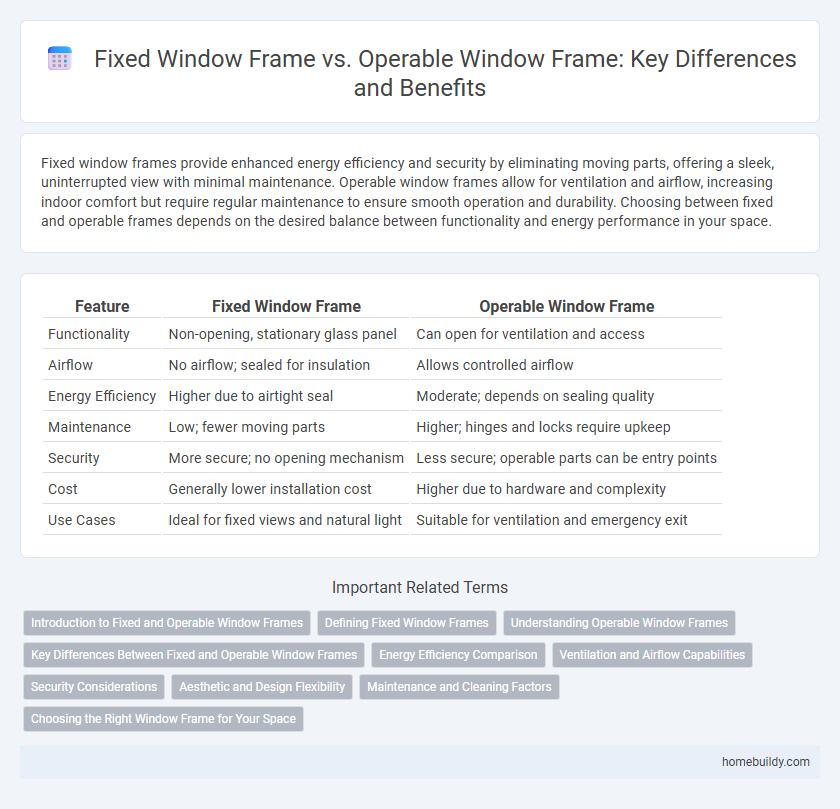Fixed window frames provide enhanced energy efficiency and security by eliminating moving parts, offering a sleek, uninterrupted view with minimal maintenance. Operable window frames allow for ventilation and airflow, increasing indoor comfort but require regular maintenance to ensure smooth operation and durability. Choosing between fixed and operable frames depends on the desired balance between functionality and energy performance in your space.
Table of Comparison
| Feature | Fixed Window Frame | Operable Window Frame |
|---|---|---|
| Functionality | Non-opening, stationary glass panel | Can open for ventilation and access |
| Airflow | No airflow; sealed for insulation | Allows controlled airflow |
| Energy Efficiency | Higher due to airtight seal | Moderate; depends on sealing quality |
| Maintenance | Low; fewer moving parts | Higher; hinges and locks require upkeep |
| Security | More secure; no opening mechanism | Less secure; operable parts can be entry points |
| Cost | Generally lower installation cost | Higher due to hardware and complexity |
| Use Cases | Ideal for fixed views and natural light | Suitable for ventilation and emergency exit |
Introduction to Fixed and Operable Window Frames
Fixed window frames consist of rigid, non-movable panes designed primarily for unobstructed views and enhanced insulation, offering superior energy efficiency due to their sealed construction. Operable window frames feature mechanisms such as hinges, sliders, or pivots, allowing ventilation and easy cleaning while providing flexibility in airflow control. Selecting between fixed and operable frames depends on functional needs like airflow, security, and energy performance within a building's design.
Defining Fixed Window Frames
Fixed window frames are non-operable structures designed to provide natural light and unobstructed views without ventilation options. These frames offer superior energy efficiency due to their airtight seal, minimizing heat transfer and reducing utility costs. Unlike operable window frames that open for airflow, fixed frames deliver enhanced durability and security by eliminating moving parts.
Understanding Operable Window Frames
Operable window frames offer enhanced ventilation and ease of cleaning compared to fixed window frames, which remain stationary and provide only natural light and views. They come in various styles such as casement, awning, and sliding, allowing for customizable airflow control in residential and commercial buildings. Choosing operable frames supports improved indoor air quality and energy efficiency by enabling users to regulate ventilation based on weather conditions.
Key Differences Between Fixed and Operable Window Frames
Fixed window frames are designed to remain stationary, offering superior energy efficiency and enhanced insulation due to their sealed construction. Operable window frames include hinges, sliders, or other mechanisms that allow the window to open, providing ventilation and easier cleaning access. Key differences lie in functionality, energy performance, and maintenance requirements, with fixed frames maximizing durability and operable frames prioritizing usability.
Energy Efficiency Comparison
Fixed window frames offer superior energy efficiency compared to operable window frames due to their airtight seal and lack of moving parts, minimizing heat transfer and air leakage. Operable window frames, while providing ventilation and flexibility, often have larger gaps and weaker seals that can reduce overall energy performance. Choosing fixed frames in energy-conscious designs enhances insulation and reduces heating and cooling costs significantly.
Ventilation and Airflow Capabilities
Fixed window frames provide excellent insulation and energy efficiency but do not allow for ventilation or airflow since they cannot be opened. Operable window frames, such as casement or sliding types, enhance indoor air quality by facilitating natural ventilation and improving airflow control. Choosing operable frames supports better temperature regulation and moisture reduction through effective air exchange.
Security Considerations
Fixed window frames provide enhanced security due to their solid construction and lack of moving parts, making them more resistant to break-ins and forced entry. Operable window frames, while offering ventilation and ease of use, may present security vulnerabilities if locking mechanisms are not robust or properly maintained. Reinforced locks, shatterproof glass, and security bars can help mitigate risks associated with operable window frames.
Aesthetic and Design Flexibility
Fixed window frames offer a sleek, uninterrupted glass surface that maximizes natural light and provides a clean, modern aesthetic ideal for minimalist designs. Operable window frames incorporate functional elements such as hinges or sliders, allowing for ventilation while adding dynamic visual interest and architectural detail to the facade. Design flexibility increases with operable frames, enabling customization in style, size, and opening mechanisms to complement various architectural themes.
Maintenance and Cleaning Factors
Fixed window frames require minimal maintenance due to their sealed design, preventing air and water infiltration that can cause damage or wear over time. Operable window frames demand regular cleaning and lubrication of moving parts such as hinges, sashes, and tracks to ensure smooth operation and prevent rust or debris buildup. Choosing between fixed and operable frames often depends on the balance between ease of maintenance and the need for ventilation or access.
Choosing the Right Window Frame for Your Space
Selecting the right window frame depends on functionality and ventilation needs; fixed window frames provide superior insulation and unobstructed views but do not open, making them ideal for spaces where airflow is not a priority. Operable window frames, such as casement or awning types, offer flexible ventilation and ease of cleaning while maintaining energy efficiency with advanced sealing technologies. Consider factors like room purpose, climate, and maintenance preferences to optimize natural light, airflow, and energy savings in your space.
fixed window frame vs operable window frame Infographic

 homebuildy.com
homebuildy.com